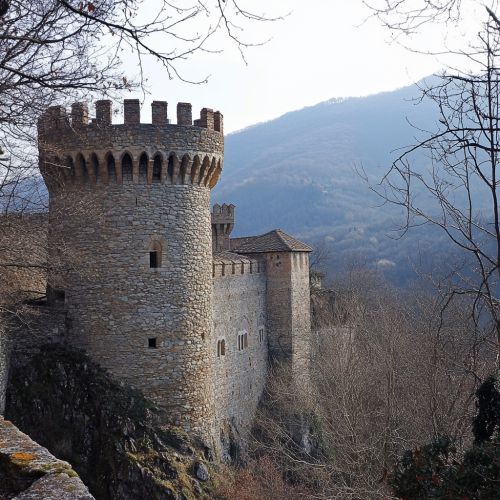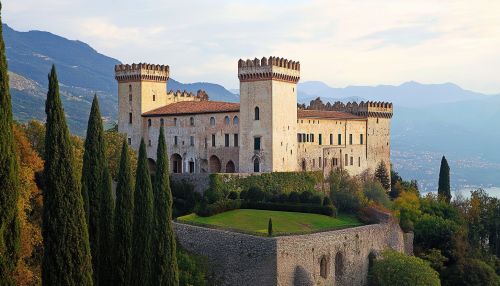Fosdinovo
History
Fosdinovo is a municipality in the province of Massa-Carrara, in the Tuscany region of Italy. The town is situated on the slopes of the Apuan Alps, offering a panoramic view of the Magra Valley and the Ligurian Sea. The history of Fosdinovo dates back to the early Middle Ages, with the first documented mention of the town appearing in the 11th century. The town's name is believed to derive from the Latin "Fauce Nova," meaning "new pass," indicative of its strategic location.
The town's historical development was significantly influenced by the Malaspina family, a powerful feudal dynasty in the region. The Malaspina family constructed the Malaspina Castle in the 12th century, which remains one of the most prominent landmarks in Fosdinovo. The castle served both as a defensive stronghold and a residence for the Malaspina lords. Over the centuries, the castle was expanded and renovated, reflecting various architectural styles, including Romanesque, Gothic, and Renaissance elements.


Geography and Climate
Fosdinovo is located at an elevation of approximately 550 meters above sea level. The town's geographical position on the Apuan Alps provides it with a unique microclimate. The climate is characterized by mild winters and warm summers, with significant variations in temperature and precipitation due to the altitude and proximity to the sea. The region experiences a Mediterranean climate, with hot, dry summers and cool, wet winters.
The terrain around Fosdinovo is predominantly hilly and mountainous, with dense forests and cultivated lands. The area is rich in natural resources, including marble from the nearby Carrara quarries, which has been used for centuries in art and architecture.
Architecture and Landmarks
The architectural heritage of Fosdinovo is a testament to its historical significance and cultural richness. The Malaspina Castle is the most notable landmark, with its imposing structure and well-preserved interiors. The castle features a central courtyard, fortified walls, and several towers, offering a glimpse into the medieval defensive architecture.
Another significant landmark is the Church of San Remigio, a Romanesque church dating back to the 12th century. The church is known for its simple yet elegant design, with a single nave and a semicircular apse. The interior houses several valuable artworks, including frescoes and sculptures from the medieval and Renaissance periods.
The town also boasts several other historical buildings, such as the Palazzo Comunale (Town Hall), which showcases Renaissance architectural elements, and the Oratorio dei Bianchi, a small chapel with Baroque decorations.
Economy
The economy of Fosdinovo has traditionally been based on agriculture, with olive oil and wine production being the primary activities. The fertile soil and favorable climate conditions make the region ideal for cultivating vineyards and olive groves. The local wines, particularly the Vermentino and Sangiovese varieties, are highly regarded for their quality.
In recent years, tourism has become an increasingly important sector for Fosdinovo's economy. The town's rich historical and cultural heritage, combined with its scenic landscapes, attracts visitors from around the world. The Malaspina Castle, in particular, is a major tourist attraction, offering guided tours and hosting various cultural events throughout the year.
Culture and Traditions
Fosdinovo has a vibrant cultural scene, with numerous festivals and events that celebrate the town's history and traditions. One of the most significant events is the annual Palio dei Micci, a traditional donkey race held in the town's main square. The event dates back to the medieval period and is a testament to the town's enduring cultural heritage.
The town also hosts several religious festivals, including the Festa di San Remigio, dedicated to the town's patron saint. The festival features processions, religious ceremonies, and various cultural activities, drawing both locals and visitors.
Fosdinovo is also known for its culinary traditions, with local dishes reflecting the region's agricultural bounty. Traditional dishes include testaroli, a type of pasta made from wheat flour, and farinata, a savory pancake made from chickpea flour.
Education and Research
Fosdinovo is home to several educational institutions, ranging from primary schools to secondary schools. The town's educational system is integrated into the broader Italian educational framework, with a focus on providing quality education to its residents.
In addition to formal education, Fosdinovo has a rich tradition of research and scholarship. The town's historical archives and libraries house valuable documents and manuscripts that provide insights into the region's history and culture. The Malaspina Castle, in particular, has been the subject of numerous historical and architectural studies, contributing to the academic understanding of medieval and Renaissance architecture.
Transportation
Fosdinovo is well-connected to the surrounding regions through a network of roads and highways. The town is accessible via the A12 motorway, which connects it to major cities such as Genoa and Pisa. Public transportation options include bus services that link Fosdinovo to nearby towns and cities.
The nearest railway station is located in Sarzana, approximately 10 kilometers from Fosdinovo. The station is part of the Genoa-Pisa railway line, providing convenient access to regional and national train services. For air travel, the closest airports are Galileo Galilei Airport in Pisa and Cristoforo Colombo Airport in Genoa, both of which offer domestic and international flights.
Demographics
As of the latest census, Fosdinovo has a population of approximately 5,000 residents. The town's demographic profile is characterized by an aging population, with a significant proportion of residents being over the age of 65. The population density is relatively low, reflecting the town's rural and mountainous setting.
The majority of Fosdinovo's residents are of Italian descent, with a small percentage of foreign-born individuals. The town has a close-knit community, with strong social ties and a sense of local identity. The local dialect, a variant of the Tuscan dialect, is still spoken by many residents, preserving the town's linguistic heritage.
Natural Environment
Fosdinovo is situated in a region of significant natural beauty, with diverse flora and fauna. The Apuan Alps, which form the backdrop to the town, are known for their rugged terrain and rich biodiversity. The area is home to several protected natural reserves, including the Parco Naturale Regionale delle Alpi Apuane, which offers opportunities for hiking, birdwatching, and other outdoor activities.
The local vegetation includes Mediterranean scrub, oak and chestnut forests, and cultivated lands with vineyards and olive groves. The region's wildlife includes various species of birds, mammals, and reptiles, making it a haven for nature enthusiasts and researchers.
Notable Residents
Over the centuries, Fosdinovo has been home to several notable individuals who have contributed to its cultural and historical legacy. One of the most prominent figures is Dante Alighieri, the renowned Italian poet, who is believed to have visited Fosdinovo during his exile. The Malaspina family, who were patrons of Dante, provided him with refuge and support during his travels.
Another notable resident is the Italian painter and sculptor, Pietro Cascella, who lived and worked in Fosdinovo. Cascella's works are known for their abstract and symbolic forms, and his legacy continues to influence the local artistic community.
